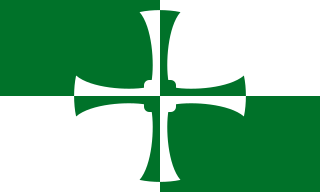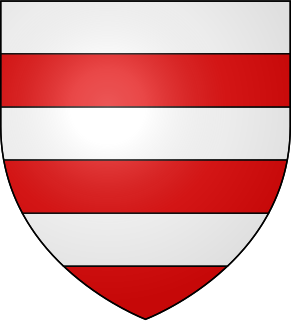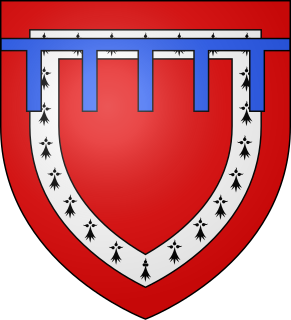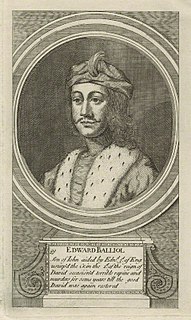
Kirkcudbrightshire, or the County of Kirkcudbright or the Stewartry of Kirkcudbright, is a historic county, registration county and lieutenancy area in the informal Galloway area of south-western Scotland. For local government purposes, it forms part of the wider Dumfries and Galloway council area of which it forms a committee area under the name of the Stewartry.

Dervorguilla of Galloway was a 'lady of substance' in 13th century Scotland, the wife from 1223 of John, 5th Baron de Balliol, and mother of John I, a future king of Scotland.

William II de Soules, Lord of Liddesdale and Butler of Scotland, was a Scottish Border noble during the Wars of Scottish Independence. William was the elder son of Nicholas II de Soules, Lord of Liddesdale and Butler of Scotland, and a cousin of Alexander Comyn, Earl of Buchan. He was the nephew of John de Soules, Guardian of Scotland.
The Battle of Dornock was fought on 25 March 1333 during the Second War of Scottish Independence.

Cummertrees is a coastal village and civil parish of Annandale in the historical county of Dumfriesshire in Dumfries and Galloway. It lies about 1 mile (1.6 km) inland, on the Pow Water, 12 miles (19 km) from Dumfries and 3 miles (5 km) from Annan.
The Motte of Urr is the remains of a 12th-century motte-and-bailey castle located near the Haugh of Urr in Dumfries and Galloway, Scotland.

Sir Ingram de Umfraville was a Scottish noble who played a particularly chequered role in the Wars of Scottish Independence, changing sides between England and Scotland multiple times, throughout the conflict.
Oswald O. Cist. was a Cistercian monk and bishop in the late 14th century and early 15th century. There is an Oswald Botelere (Butler) granted a safe-conduct, along with 12 others, to enter England and study at the University of Oxford, in 1365, but this Oswald Butler cannot be shown to be the same as the later Oswald of Glenluce.

Hugh de Balliol, Lord of Bywell, Barnard Castle and Gainford, was a 12th and 13th century nobleman. He was the son of Eustace de Balliol and Petronilla FitzPiers. Balliol was a supporter of King John of England during the Barons Wars of 1215-17.
Sir Philip Mowbray or Philip de Mowbray was a Scottish noble who opposed Robert the Bruce in the Wars of Scottish Independence. He later changed his allegiance to Scotland and was killed in 1318 fighting in Ireland.

Corsock is a village the historical county of Kirkcudbrightshire, Dumfries and Galloway, south-west Scotland. It is located 8 miles (13 km) north of Castle Douglas, and the same distance east of New Galloway, on the Urr Water.

Edward Balliol was a pretender to the Scottish throne during the Second War of Scottish Independence. With English help, he ruled parts of the country from 1332 to 1356.
Eustace fitz John was a powerful magnate in northern England during the reigns of Henry I, Stephen and Henry II. From a relatively humble background in the south-east of England, Eustace made his career serving Henry I, and was elevated by the king through marriage and office into one of the most important figures in the north of England. Eustace acquired a great deal of property in the region, controlled Bamburgh Castle, and served jointly with Walter Espec as justiciar of the North.
Sir Andrew Murray (1298–1338), also known as Sir Andrew Moray, or Sir Andrew de Moray, was a Scottish military and political leader who supported David II of Scotland against Edward Balliol and King Edward III of England during the so-called Second War of Scottish Independence. He held the lordships of Avoch and Petty in north Scotland, and Bothwell in west-central Scotland. In 1326 he married Christina Bruce, a sister of King Robert I of Scotland. Murray was twice chosen as Guardian of Scotland, first in 1332, and again from 1335 on his return to Scotland after his release from captivity in England. He held the guardianship until his death in 1338.

Sir Henry de Baliol of Cavers was Chamberlain of Scotland.
Gilbert de Umfraville was a 13th-century baron. Gilbert was the eldest son of Richard de Umfraville, Lord of Redesdale. He succeeded his father as Lord of Redesdale and Baron Prudhoe from 1226 at his seat of Prudhoe Castle. He also had lands at Otterburn.

Château de Tours-en-Vimeu was a castle near Tours-en-Vimeu, Hauts-de-France, France.
Robert Service (1854-1911) was a British nurseryman and naturalist.
Nicholas de Soules, Lord of Liddesdale and Butler of Scotland, was a 13th-century Scottish Border noble.
William de Percy, sixth feudal baron of Topcliffe, was an English noble.










